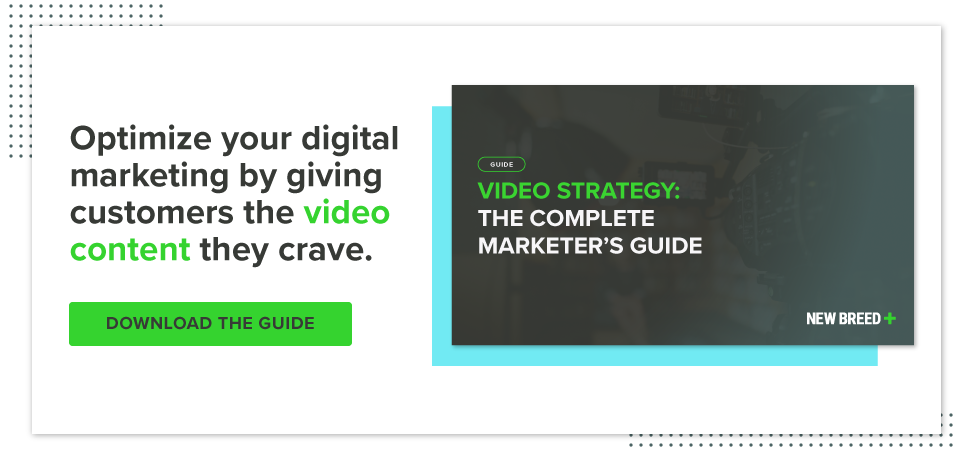
As more and more people use video in their buying process, more brands are bolstering their video marketing strategy. In this crowded marketplace, developing compelling content is an ideal way to break through the noise.
Engaging video content looks different for everyone and is often dependent on the interests of your target audience. However, a rule for writing engaging copy is just as important to video marketing: show, don’t tell.
Showing Versus Telling
No matter what content you’re producing, showing rather than telling is the ideal way to make it more engaging to your audience. Instead of listing features or telling your readers what to think or do, showing helps plant the idea in your reader’s head through description or visuals. Content that shows and doesn’t tell enables your reader to picture themselves in a situation more clearly and relate it back to their own experience.
Say you’re reading a blog post about a reporting software you’re interested in purchasing. It reads: Our software offers a reporting dashboard that enables you to track customer satisfaction.
You may know what the product does but it isn’t compelling. Showing guides the reader to how that software ultimately fulfills their need or challenge. A line that shows might read: For customer success managers, knowing which customers are struggling is half the battle. Our customer reporting software provides a visual representation of satisfaction with a color-coded dashboard.
In this case, descriptive copy and real-world scenarios paint a vivid picture of how that software will benefit the reader’s business.
Showing in Video Marketing
How does this translate to video marketing? For the same reason that your written marketing content shouldn’t tell an audience what to think or do, neither should your video marketing.
Showing not telling in your video marketing may seem like you can’t talk directly to the camera, but that couldn’t be further from the truth. As long as you keep the same principle of descriptive language and offering relatable scenarios in mind, you can create compelling content that is relevant to your audience.
Regardless of how you show and not tell in your video marketing, the same questions should always come to mind. What do you want your audience to think, feel and do after watching your video? By having an answer to each of those questions, you are better positioned to show your audience the necessary content to guide them to those destinations, rather than telling them to think or feel a certain way.
With that in mind, here are some methods you can use to show and not tell in your video marketing:
Supporting footage or animation (b-roll)
Done properly, talking head videos can still show and not tell. However, you can take your video marketing to the next level by bringing in supporting footage or “b-roll.” Footage that is relevant to the narration or voiceover can expand on the picture you’re painting with your words.
Supporting footage or animation enables you to spend less time talking about something and more time showing it. Rather than describing common challenges in a laboratory setting, you can show footage of struggling scientists and broken beakers. By providing a visual, your audience is more likely to see themselves in the given situation, especially if content aligns closely with their pain points and challenges.
B-roll or animation can be planned and created for your video, or you can leverage stock video resources like Shutterstock or Pexels.
Screen recordings
Video marketing offers an excellent opportunity to provide supporting visuals to your content and empowers you to show and not tell. Much like my earlier example, product demonstration videos enable you to talk about your solution and align with your target customer’s pain points.
Through video, you can provide a corresponding visual through screen recordings. Pairing your descriptive voiceover with visuals gives your audience a more comprehensive understanding and more evidence of the benefit your product offers. Rather than stating the benefit of your product in a voiceover, showcase through a real-world example.
Customer testimonials
Finally, customer testimonials are a great way to show your audience how your product provides a benefit. If the show, don’t tell mentality does anything, it backs up your statements with proof. It’s easy to tell a prospect that your product is great. It’s harder to show why it’s great.

Customer testimonial videos let your customers do the showing by providing a use case of your products to viewers and describing the impact of your product or solution. Again, these videos can still be talking heads. The showing doesn’t necessarily come from the visual, it can come from how and why a person talks about your product versus simply saying it does what it does.
Visualizing Abstract Concepts
In the B2B and SaaS industries, many marketers may find themselves struggling to visualize the abstract concepts that they deal with. It can be very simple to visualize the pain points of someone in the market for new running shoes, but less so for someone struggling to understand why their paid advertising campaigns aren’t working.

Video can offer an avenue for marketers to showcase similar concepts simply because of its visual nature. Moz is an excellent example of leveraging video content to show and not tell. Their Whiteboard Friday videos enable their experts to describe abstract concepts in detail and provide visuals for viewers by utilizing a whiteboard throughout the video to support their talk track.
Takeaway
Showing and not telling in your video marketing doesn’t mean you can’t be speaking directly to the camera. There are a number of ways you can continue to show and not tell across content mediums.
By utilizing descriptive language and relevant, real-world scenarios, you can create compelling video content that captures and retains the attention of your audience. Marketers can leverage the visual nature of video to make it easier to show audiences their message and empower audiences to think and feel certain ways or take a desired action.
Chris Singlemann
Chris is a Brand Marketer at New Breed where he is responsible for crafting design and video assets that support our brand. When he's not behind the camera, he enjoys kayaking and tending to his sourdough starter.





